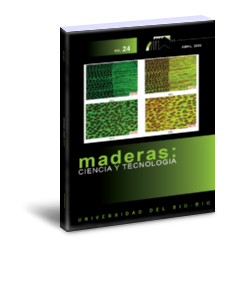Optimization of cnc operating parameters to minimize surface roughness of Pinus sylvestris using integrated artificial neural network and genetic algorithm
Keywords:
Artificial neural network, genetic algorithm, modeling, Pinus sylvestris, optimization, surface roughnessAbstract
The surface roughness of wood is affected by the processing conditions and the material structure. So, optimization of operation parameters is very crucial to have minimum surface roughness. In this study, modeling and optimization of surface roughness (Ra) of Scotch pine (Pinus sylvestris) was investigated. Firstly, the samples were cut under different conditions 8 mm, 9 mm and 11mm depth of cut and 12 mm, 14 mm and 16 mm axial depth of cut) in computer numerical control (CNC) machine, and then surface roughness (Ra) values of samples were calculated. Then a prediction model of surface roughness was developed using artificial neural networks (ANN). Optimization process was carried out to reach minimum surface roughness of wood samples by the genetic algorithm (GA) method. MAPE value of the ANN model was found lower than 4,0 %. The optimum CNC operation parameters were 1874,5 rad/s, 3,0 m/min feed rate, 9,7 mm depth of cut and 12 mm for axial depth of cut for minimum surface roughness. As a result of study, surface roughness of Scotch pine wood can be modeled and optimized using integrated ANN and GA methods by saving time and cost.
Downloads
References
ASTM. 1994. Standard test methods for conducting machining tests of wood and wood-base materials.
ASTM. D 1666-87. 1994. ASTM Standards:PA, USA. https://www.astm.org/DATABASE.CART/HISTORICAL/
D1666-87R04.htm
Asilturk, I.; Cunkas, M. 2011. Modeling and prediction of surface roughness in turning operations using artificial neural network and multiple regression method. Expert Syst Appl 38(5): 5826-5832. https://doi.org/10.1016/j.eswa.2010.11.041
Bonac, T. 1979. Wood roughness volume and depth estimated from pneumatic surface measurements. Wood Sci 11: 227-232. https://pascal-francis.inist.fr/vibad/index.php?action=getRecordDetail&idt=PASCAL7960435484
Burdurlu, E.; Usta, I.; Ulupinar, M.; Aksu, B.; Erarslan, T.Ç. 2005. The effect of the number of blades and the grain size of abrasives in planing and sanding on the surface roughness of European black pine and Lombardy poplar. Turk J Agric For 29(4): 315-322. http://journals.tubitak.gov.tr/agriculture/issues/tar-05-29-4/tar-29-4-11-0403-12.pdf
De Deus, P.R.; de Sampaio Alves, M.C.; Vieira, F.H.A. 2015. The quality of MDF workpieces machined in CNC milling machine in cutting speeds, feedrate, and depth of cut. Meccanica 50(12): 2899-2906. https://doi.org/10.1007/s11012-015-0187-z
DIN. 4768. 1990. Determination of values of surface roughness parameters Ra, Rz, Rmax using electrical contact (Stylus) instruments, Concepts and measuring conditions. Deutsches Institut für Normung: Berlin, Germany. https://infostore.saiglobal.com/en-us/standards/din-4768-e-1990-383197_saig_din_din_870873/
Gawroński, T. 2013. Optimisation of CNC routing operations of wooden furniture parts. Int J Adv Manuf Tech 67(9-12): 2259-2267. https://doi.org/10.1007/s00170-012-4647-5
Haykin, S. 1994. Neural networks: a comprehensive foundation. Prentice Hall PTR: Upper Saddle River, NJ, United States. https://dl.acm.org/doi/book/10.5555/541500
Hazir, E.; Koc, K.H. 2016. Optimization of wood surface machining parameters in CNC routers: Response surface methodology (RSM) approach. Int J Sci Eng Technol 5: 1-8.
Hazir, E.; Koc, K.H. 2018. A modeling study to evaluate the quality of wood surface. Maderas-Cienc Tecnol 20(4): 691-702. http://dx.doi.org/10.4067/S0718-221X2018005041501
Hazir, E.; Koc, K.H. 2019. Optimization of wood machining parameters in CNC routers: Taguchi orthogonal array based simulated angling algorithm. Maderas-Cienc Tecnol 21(4): 493-510. http://dx.doi.org/10.4067/S0718-221X2019005000406
Hazir, E.; Ozcan, T. 2019. Response surface methodology integrated with desirability function and genetic algorithm approach for the optimization of CNC machining parameters. Arab J Sci Eng 44(3): 2795-2809. https://doi.org/10.1007/s13369-018-3559-6
Kant, G.; Sangwan, K.S. 2015. Predictive modelling and optimization of machining parameters to minimize surface roughness using artificial neural network coupled with genetic algorithm. Procedia CIRP 31: 453-458. https://doi.org/10.1016/j.procir.2015.03.043
Kilic, M.; Hiziroglu, S.; Burdurlu, E. 2006. Effect of machining on surface roughness of wood. Build Environ 41(8): 1074-1078. https://doi.org/10.1016/j.buildenv.2005.05.008
Koc, K.H.; Erdinler, E.S.; Hazir, E.; Ozturk, E. 2017. Effect of CNC application parameters on wooden surface quality. Measurement 107: 12-18. https://doi.org/10.1016/j.measurement.2017.05.001
Kumar, S.L. 2018. Experimental investigations and empirical modeling for optimization of surface roughness and machining time parameters in micro end milling using Genetic Algorithm. Measurement 124: 386-394. https://doi.org/10.1016/j.measurement.2018.04.056
Mirjalili, S. 2015. Moth-flame optimization algorithm: A novel nature-inspired heuristic paradigm. Knowledge-Based Systems 89: 228-249. https://doi.org/10.1016/j.knosys.2015.07.006
Patel, R.D.; Oza, N.V.; Bhavsar, S.N. 2014. Prediction of surface roughness in CNC milling machine by controlling machining parameters using ANN. Int J Mech Eng Robot Res 3(4): 353. http://www.ijmerr.com/ show-129-488-1.html
Peters, C.; Cumming, J.D. 1970. Measuring wood surface smoothness: a review. Forest Prod J 20(12): 40-43. https://www.cabdirect.org/cabdirect/abstract/19706607097 Prakash, S.; Palanikumar, K. 2011. Modeling for prediction of surface roughness in drilling
MDF panels using response surface methodology. J Compos Mater 45(16): 1639-1646. https://doi.org/10.1177/0021998310385026
Sofuoglu, S.D. 2015a. Using artificial neural networks to model the surface roughness of massive wooden edge-glued panels made of Scotch pine (Pinus sylvestris L.) in a machining process with computer numerical control. BioResources 10(4): 6797-6808. https://ojs.cnr.ncsu.edu/index.php/BioRes/article/view/BioRes_10_4_6797_Sofuoglu_Artificial_Neural_Networks_Roughness_Pine/3804
Sofuoglu, S.D. 2015b. Determination of optimal machining parameters of massive wooden edge-glued panels made of European larch (Larix decidua Mill.) using Taguchi design method. BioResources 10(4): 7772-7781. https://ojs.cnr.ncsu.edu/index.php/BioRes/article/view/BioRes_10_4_7772_Sofuoglu_Determination_Optimal_Machining_Parameters/3897
Stanojevic, D.; Mandic, M.; Danon, G.; Svrzic, S. 2017. Prediction of the surface roughness of wood for machining. J For Res 28(6): 1281-1283. https://doi.org/10.1007/s11676-017-0401-z Sutcu, A. 2013. Investigation of parameters affecting surface roughness in CNC routing operation on wooden EGP. BioResources 8(1): 795-805. https://ojs.cnr.ncsu.edu/index.php/BioRes/article/view/BioRes_08_1_Sutcu_795_Parameters_Surface_Roughness/1921
Thoma, H.; Peri, L.; Lato, E. 2015. Evaluation of wood surface roughness depending on species characteristics. Maderas-Cienc Tecnol 17(2): 285-292. http://dx.doi.org/10.4067/S0718-221X2015005000027
Tiryaki, S. 2014. Effecting factors on surface roughness in wood machining. Turkish J For 15(2): 176-182. https://dergipark.org.tr/tr/pub/tjf/issue/20903/224498
Tiryaki, S.; Malkocoglu, A.; Ozsahin, S. 2014. Using artificial neural networks for modeling surface roughness of wood in machining process. Constr Build Mater 66: 329-335. https://doi.org/10.1016/j.conbuildmat. 2014.05.098
TS. 2471. 2005. Wood, Determination of Moisture Content for Physical and Mechanical Tests. TS. 2471. 2005. Turkish Standardization Institute: Ankara, Turkey. https://intweb.tse.org.tr/Standard/Standard/Standard.
aspx?081118051115108051104119110104055047105102120088111043113104073082090099088118111107
Downloads
Published
How to Cite
Issue
Section
License

This work is licensed under a Creative Commons Attribution 4.0 International License.
Los autores/as conservarán sus derechos de autor y garantizarán a la revista el derecho de primera publicación de su obra, el cuál estará simultáneamente sujeto a la Licencia de Reconocimiento de Creative Commons CC-BY que permite a terceros compartir la obra siempre que se indique su autor y su primera publicación esta revista.
































